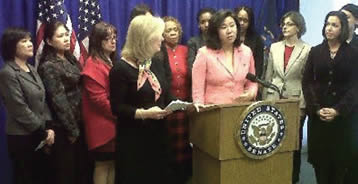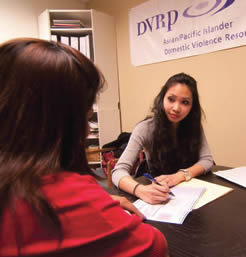By Susan R. Paisner


Those are the words of Indira, a 36-year-old immigrant from India, and a domestic violence survivor living in northern Virginia. Her story is not all that unusual for an Asian American female. A study from the Asian & Pacific Islander Domestic Violence Resource Project (DVRP) states 41- 61% of Asian women report experiencing physical and/or sexual violence by an intimate partner during their lifetime.
Indira was an immigrant dependent on her U.S. citizen husband for financial support, living with him and his parents and sister, all of whom abused her verbally and emotionally. “They treated me like a maid in the house,” she said, “expecting me to do all the housework at every gathering, every party. And still the sister would yell at me.”
Domestic violence has a core set of behaviors that occur in all abusive relationships, but there are different sets of problems and challenges in specific cultures for survivors. Within the Asian and Pacific Islander communities, one of the major differences is with the tactics used by aggressors, said Jessica Li, Director of Programs for DVRP, a national resource center and clearinghouse on gender violence. The group also provides services to survivors of domestic violence in Washington D.C., Maryland and Virginia.
Instead of the usual efforts to “pull” the female victim back into the relationship, such as asking for forgiveness after a violent episode, aggressors use tactics that “push” her away, such as saying the abuser could divorce her, or have her deported. Said Li: “Within the API culture, women are taught to hold their families together. When one of them asks for help [such as calling the police], that can be considered a sign of weakness.”
Another difference for Asians in America, illustrated by Indira’s story, is that there are often multiple batterers. An assessment DVRP conducted found that close to 30% of abuse came from in- laws. This abuse is usually emotional or financial.
At 41% to 61%, the domestic violence rates for AAPIs are higher than the rates for other groups in national studies reported by the San Francisco-based Asian & Pacific Islander Institute on Domestic Violence: Whites (21.3%), African Americans (26.3%), Hispanics of any race (21.2%), people of mixed race (27.0%), and American Indians and Alaskan Natives (30.7%).
Amara Tek, DVRP Program Coordinator, pointed out that Indira – speaking fluent English and holding both undergraduate and graduate degrees – was “a little unique compared to what a lot of our clients are going through.”
Indira agreed, saying “If you don’t know the language, it’s hard to seek help.” But her academic degrees and command of English initially meant nothing in terms of employment, because her husband “sabotaged” her Green Card process by giving Immigration his parents’ address. (Indira and he had already moved out).
Even though she had no way to work legally in America, the family harangued her for not bringing money in. As Indira related, they would say, “You’re not trying. You’re not working. You just do nothing and you’re a burden and getting fat.”
It wasn’t until she and her husband moved out, however, that the physical violence began.
So after the fifth year of marriage, and the second major beating, she finally called the police. Through friends, she found herself “getting stronger.” She moved out, found a lawyer, and obtained her Green Card.
At that point, she connected with DVRP. “I already had my protective order,” she said. “But I was very scared, very timid. I was all by myself here, no family, no support. My DVRP advocate was with me during my divorce process in court – when I would be facing my ex, who would come with his whole family. Women going through this need someone by their side, not just being on the phone saying ‘go to this website.’”
Also critical, said DVRP’s Li, is providing culturally linguistic services in the Washington, D.C. area. The police in particular should ask what language the woman speaks. “What we find,” said Li, “is the woman is afraid of the police because of her experience back home with authorities.” Providing an interpreter and being culturally aware must be integral components of an effective law enforcement response.
But, Li added, “All of us in this community need to be aware of what domestic violence is and where survivors can get services. Because you never know when your neighbor or your sister could come to you for help—or be in that situation yourself.”
Indira’s advice: “Seek help. Don’t keep it to yourself. There are resources available; don’t feel alone. When I started looking out for help, I found it.”
And now, as a DVRP advocate, she also gives it.
 Asian Fortune Your source for all things Asian American
Asian Fortune Your source for all things Asian American

